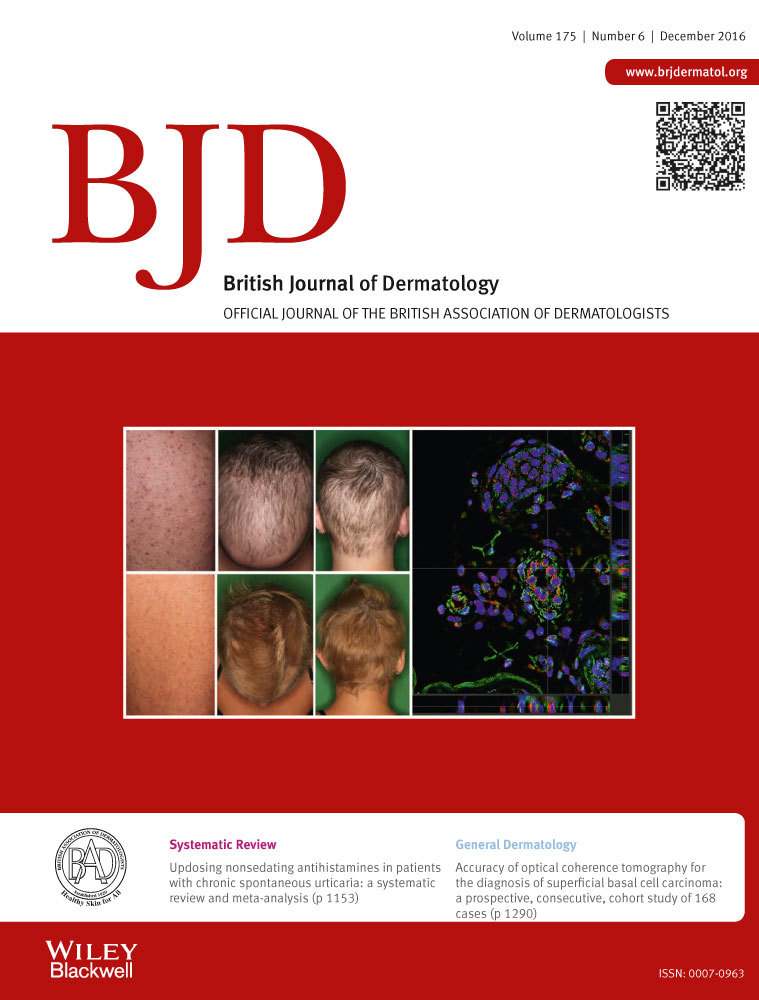Commentaries
Antihistamine updosing in chronic urticaria – is there enough evidence?
K. Weller,
M. Maurer,
K. Weller
Department of Dermatology and Allergy, Charité – Universitätsmedizin Berlin, Charitéplatz 1, 10117 Berlin, Germany
Search for more papers by this authorM. Maurer
Department of Dermatology and Allergy, Charité – Universitätsmedizin Berlin, Charitéplatz 1, 10117 Berlin, Germany
Search for more papers by this authorK. Weller,
M. Maurer,
K. Weller
Department of Dermatology and Allergy, Charité – Universitätsmedizin Berlin, Charitéplatz 1, 10117 Berlin, Germany
Search for more papers by this authorM. Maurer
Department of Dermatology and Allergy, Charité – Universitätsmedizin Berlin, Charitéplatz 1, 10117 Berlin, Germany
Search for more papers by this authorAbstract
Linked Article: Guillén-Aguinaga et al. Br J Dermatol 2016; 175:1153–1165.
References
- 1Zuberbier T, Aberer W, Asero R et al. The EAACI/GA(2) LEN/EDF/WAO Guideline for the definition, classification, diagnosis, and management of urticaria: the 2013 revision and update. Allergy 2014; 69: 868–87.
- 2Church MK, Maurer M, Simons FE et al. Risk of first-generation H(1)-antihistamines: a GA(2)LEN position paper. Allergy 2010; 65: 459–66.
- 3Guillén-Aguinaga S, Jáuregui Presa I, Aguinaga-Ontoso E et al. Updosing nonsedating antihistamines in patients with chronic spontaneous urticaria: a systematic review and meta-analysis. Br J Dermatol 2016; 175: 1153–65.
- 4Maurer M, Weller K, Bindslev-Jensen C et al. Unmet clinical needs in chronic spontaneous urticaria. A GA(2)LEN task force report. Allergy 2011; 66: 317–30.
- 5Abajian M, Curto-Barredo L, Krause K et al. Rupatadine 20 mg and 40 mg are effective in reducing the symptoms of chronic cold urticaria. Acta Derm Venereol 2016; 96: 56–9.
- 6Krause K, Spohr A, Zuberbier T et al. Up-dosing with bilastine results in improved effectiveness in cold contact urticaria. Allergy 2013; 68: 921–8.
- 7Magerl M, Pisarevskaja D, Staubach P et al. Critical temperature threshold measurement for cold urticaria: a randomized controlled trial of H(1)-antihistamine dose escalation. Br J Dermatol 2012; 166: 1095–9.
- 8Siebenhaar F, Degener F, Zuberbier T et al. High-dose desloratadine decreases wheal volume and improves cold provocation thresholds compared with standard-dose treatment in patients with acquired cold urticaria: a randomized, placebo-controlled, crossover study. J Allergy Clin Immunol 2009; 123: 672–9.
- 9Zhao ZT, Ji CM, Yu WJ et al. Omalizumab for the treatment of chronic spontaneous urticaria: a meta-analysis of randomized clinical trials. J Allergy Clin Immunol 2016; 137: 1742–50 e4.
- 10Grattan CE, O'Donnell BF, Francis DM et al. Randomized double-blind study of cyclosporin in chronic ‘idiopathic’ urticaria. Br J Dermatol 2000; 143: 365–72.
- 11Vena GA, Cassano N, Colombo D et al. Cyclosporine in chronic idiopathic urticaria: a double-blind, randomized, placebo-controlled trial. J Am Acad Dermatol 2006; 55: 705–9.
- 12McBayne TO, Siddall OM. Montelukast treatment of urticaria. Ann Pharmacother 2006; 40: 939–42.
- 13Weller K, Groffik A, Church MK et al. Development and validation of the Urticaria Control Test: a patient-reported outcome instrument for assessing urticaria control. J Allergy Clin Immunol 2014; 133: 1365–72, 72 e1–6.




